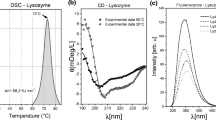Abstract
Heat aggregation of human IgG has been studied by photon correlation spectroscopy, ultracentrifugation, circular dichroism, and differential scanning calorimetry. It is found that pooled human IgG can be separated into two fractions of molecules, one that easily aggregates and one that is stable upon heating. In a buffer atpH=7.6 and 0.2 M NaCl it is found that about half of the original monomeric molecules do not aggregate even after heating at 62°C for 24 h. No differences in the antigen binding capacity of the heat-stable fraction and normal IgG are observed. Heat-stable molecules can partially be transformed to heat-aggregating molecules by a rapid acid denaturation followed by neutralization. Differential scanning calorimetry shows that the major heat denaturation, which is a two-phase process atpH=7.6, starts at about 63°C. Only minor differences between the heat-stable and the heat-labile fractions are observed in the thermograms. No differences are observed in the far-UV region of the CD spectra, indicating that the secondary structure of the heat-stable IgG does not differ from the native IgG molecule. While the aggregation of normal human IgG can be described by Smoluchowski kinetics, the heat-stable fraction follows another kinetics, which includes an activation step.
Similar content being viewed by others
References
Amzel, L. M., and Poljak, R. J. (1979).Annu. Rev. Biochem. 48, 961–997.
Augener, W., and Grey, H. M. (1970).J. Immunol. 105, 1024–1030.
Capra, J. D., and Kunkel, H. G. (1970).J. Clin. Invest. 49, 610–621.
Chen, S. H., Veldkamp, W. B., and Lai, C. C. (1975).Rev. Sci. Instrum. 46, 1356–1364.
Christian, C. L. (1958).J. Exp. Med. 108, 139–157.
Christian, C. L. (1960).J. Immunol. 84, 112–121.
Cohen, J. J., Goodfriend, L., and Rose, B. (1967).Can. J. Biochem. 45, 609–611.
Feder, J., and Jøssang, T. (1985). InScaling Phenomena in Disordered Systems (Pynn, R., and Skjeltorp, A., eds.), Plenum Press, New York, pp. 99–131.
Hansson, U. B. (1968).Acta Chem. Scand. 22, 953–960.
Harbitz, O., Tenningen, A., Martens, H., and Buer, D. (1984).Thermochim. Acta 72, 201–204.
Jøssang, T., Feder, J., and Rosenqvist, E. (1985).J. Chem. Phys. 82, 574–589.
Klein, M. (1973).Immunochemistry 10, 673–680.
Knutson, D. W., Kijlstra, A., Lentz, H., and van Es, L. A. (1979).Immunol. Commun. 8(3), 337–345.
Litman, G. W., Gerber-Jenson, B., Litman, R., Middaugh, C. R., and Scheffel, C. (1980).Mol. Immunol. 17, 337–344.
Michaelsen, T. E., Frangione, B., and Franklin, E. C. (1977).J. Immunol. 119, 558–563.
Morse, J. (1965).J. Immunol. 95, 722–927.
Oncley, J. L., Scatchard, G., and Brown, A. (1947).J. Phys. Coll. Chem. 51, 184–198.
Oreskes, I., and Mandel, D. (1981).Rev. Rhumatisme (Numero speciale)1981 (June), Abstract 0633.
Tischenko, V. M., Zav'yalov, V. P., Medgyesi, G. A., Potekhin, S. A., and Privaliov, P. L. (1982).Eur. J. Biochem. 126, 517–521.
Vandenbranden, M., de Coen, J. L., Jeener, R., Kanarek, L., and Ruyschaert, J. M. (1981).Mol. Innunol. 18, 621–631.
Zavodszky, P., Jaton, J. C., Ventyaminov, S. Y., and Medgyesi, G. A. (1981).Mol. Immunol. 18, 39–46.
Zinneman, H. H., and Seal, U. S. (1971).Eur. J. Clin. Biol. Res. 16, 668–672.
Author information
Authors and Affiliations
Rights and permissions
About this article
Cite this article
Rosenqvist, E., Jøssang, T., Feder, J. et al. Characterization of a heat-stable fraction of human IgG. J Protein Chem 5, 323–333 (1986). https://doi.org/10.1007/BF01025961
Received:
Published:
Issue Date:
DOI: https://doi.org/10.1007/BF01025961




